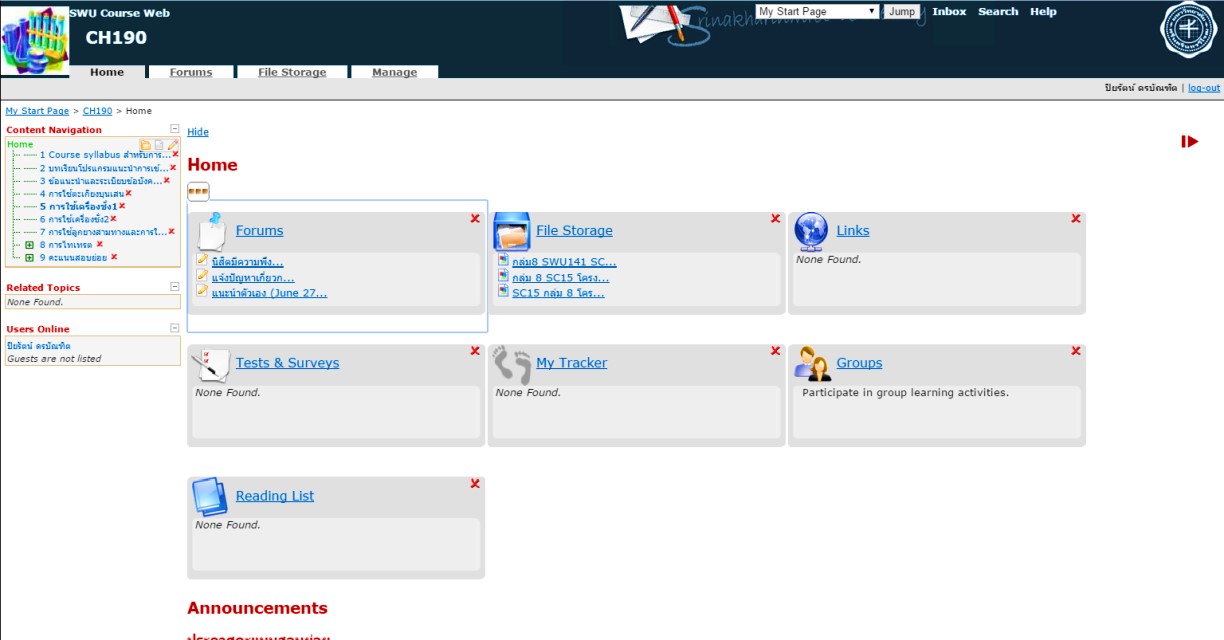ผลของการใช้บทเรียนโปรแกรมแนะนำการเข้าห้องปฏิบัติการเคมีออนไลน์สำหรับนิสิตชั้นปีที่ 1 ระดับปริญญาตรี คณะวิทยาศาสตร์
Main Article Content
Abstract
Piyarat Dornbundit, Pan Tongraung and Alisa Senamontri
รับบทความ: 5 กันยายน 2558; ยอมรับตีพิมพ์: 20 พฤศจิกายน 2558
บทคัดย่อ
งานวิจัยครั้งนี้มีจุดประสงค์เพื่อพัฒนาบทเรียนโปรแกรมแนะนำการเข้าห้องปฏิบัติการเคมี ออนไลน์ เรื่อง เทคนิคการแยกสาร และศึกษาประสิทธิผลทางการเรียนของนิสิตชั้นปีที่ 1 ระดับปริญญาตรี กลุ่มที่ศึกษา ได้แก่ นิสิตชั้นปีที่ 1 สาขาวิชาเคมี คณะวิทยาศาสตร์ มหาวิทยาลัยศรีนครินทรวิโรฒ ซึ่งลงทะเบียนเรียนในรายวิชาปฏิบัติการเคมีทั่วไป (คม 190) ภาคเรียนที่ 1 ปีการศึกษา 2557 จำนวน 49 คน โดยใช้กลุ่มเป็นหน่วยการสุ่มอย่างง่ายได้ 2 กลุ่ม แบ่งเป็นกลุ่มควบคุม จำนวน 27 คน และกลุ่มทดลอง จำนวน 22 คน เครื่องมือวิจัย ได้แก่ บทเรียนโปรแกรมแนะนำการเข้าห้องปฏิบัติการเคมีออนไลน์ เรื่อง เทคนิคการแยกสาร แบบทดสอบระหว่างการเรียนรู้ และแบบทดสอบวัดผลสัมฤทธิ์ทางการเรียน สถิติที่ใช้ในการวิเคราะห์ข้อมูล ได้แก่ สถิติที่ใช้หาประสิทธิภาพของการทดลองเสมือนด้วยค่า E1/E2 โดยกำหนดเกณฑ์ไม่น้อยกว่า 80/80 สถิติที และสถิติเชิงพรรณนา ได้แก่ ร้อยละ ค่าเฉลี่ย และส่วนเบี่ยงเบนมาตรฐาน ผลการหาประสิทธิภาพของบทเรียนโปรแกรมแนะนำการเข้าห้องปฏิบัติการเคมีออน-ไลน์ เรื่อง เทคนิคการแยกสาร โดยการศึกษานำร่องกับนิสิตชั้นปีที่ 1 สาขาเคมี คณะวิทยาศาสตร์ มหาวิทยาลัยศรีนครินทรวิโรฒ จำนวน 30 คน พบว่า บทเรียนโปรแกรมแนะนำการเข้าห้องปฏิบัติ การเคมีออนไลน์ เรื่อง เทคนิคการแยกสาร มีประสิทธิภาพ 80.67/83.05 ซึ่งเป็นไปตามเกณฑ์ E1/E2 ที่กำหนดไว้ จากการทดสอบกับกลุ่มที่ศึกษา พบว่า นิสิตที่เรียนรู้ด้วยบทเรียนโปรแกรมแนะนำการเข้าห้องปฏิบัติการเคมีออนไลน์ มีคะแนนผลสัมฤทธิ์ทางการเรียนหลังเรียนสูงกว่าก่อนเรียน (p < .05) และเมื่อเปรียบเทียบระหว่างนิสิตที่เรียนรู้ด้วยการทดลองเสมือนและนิสิตที่เรียนรู้แบบปกติ พบว่า นิสิตทั้งสองกลุ่มมีผลสัมฤทธิ์ทางการเรียนแตกต่างกัน (p < .05)
คำสำคัญ: บทเรียนโปรแกรม ออนไลน์ ปฏิบัติการเคมี ระบบออนไลน์
Abstract
The purposes of this study aimed at developing online chemical introduction program to study the learning efficiency of the first-year chemistry undergraduates, Faculty of Science, Srinakharinwirot University. The participants consisted of 49 students who enrolled into General Chemistry Laboratory (CH190) course in the second semester of academic year 2014. They were separated into 2 groups by using the simple random sampling, i.e., 27 students in the controlled group as well as 22 students in the experimental group. The research instruments were an Online Chemical Introduction Program, sub-testing form and learning achievement test. The data were statistically analyzed to investigate the effectiveness of the experiment using E1/E2 which should not be less than the criteria 80/80. The t-test, and descriptive statistics (i.e., percentage, mean and standard deviation) were also used. The program on separation techniques was tested in a pilot study with 30 first-year students, Faculty of Science, Srinakharinwirot University. The findings revealed that the program gained the effectiveness of 80.67/ 83.05 which reached the criteria of E1/E2. The finding with participant groups showed that the students who learned by using the program had significantly higher achievement than those before learning (p < .05). When comparing between students learned with the virtual practical and regular education, the achievements of students learned with the virtual practical were higher than those learned with regular education (p < .05).
Keywords: Programmed instruction, Online, Chemical practical, Undergraduate level
Downloads
Article Details

This work is licensed under a Creative Commons Attribution-NonCommercial 4.0 International License.
References
Ditcharoen, N., Polyiam, K., Vangkahad, P. and Jarujamrus, P. (2014). Development of learning media in topics of atomic structure and chemical bond with augmented reality technology. Journal of Research Unit on Science, Technology and Environment for Learning 5(1): 21–27. (in Thai)
Khan, B. H., ed. (1997). Web-Based Instruction. Englewood Cliff, NJ: Educational Technologies.
Laohajaratsang, T. (2001). Web-based instruction: Innovation for teaching quality. Suksasartsan (Faculty of Education, Chiang Mai University) 28(2): 87–94. (in Thai)
Olson, T. M., and Wisher, R. A. (2002). The Effectiveness of web-based instruction: An initial inquiry. The International Review of Research in Open and Distributed Learning 3(2): 1–17.
Phornphisutthimas, S. (2008). Teaching science underlining process skills. Advanced Science Journal 8(2):28–38. (in Thai)
Phornphisutthimas, S. (2013). Learning management of science in 21st century. Journal of Research Unit on Science, Technology and Environment for Learning 4(1): 55–63. (in Thai)
Phornphisutthimas, S., Koben, J., Laloknam, S., Limchoowong, S., and Poopityastaporn, K. (2008, July). Learning biomolecules through an online-learning lesson by using constructivist learning model at undergraduate level. The 4th Naresuan Research Conference. Pisanulok: Naresuan University. (in Thai)
Phornphisutthimas, S., Panijpan, B., Wood, E. J., and Booth, A. G. (2007). Improving Thai students’ understanding of concepts in protein purification by using Thai and English versions of a simulation program. Biochemistry and Molecular Biology Education 35(5): 316–321.
Promso, C., Saejueng, P., and Wuttisela, K. (2015). Study on normalized learning gains and concepts of molecular shape and polar covalent bond learning through augmented reality technology. Journal of Research Unit on Science, Technology and Environment for Learning 6(1): 57–69. (in Thai)
Tatli, Z., and Ayas, A. (2013). Effect of a virtual chemistry laboratory on students’ achievement. Educational Technology & Society 16(1): 159–170.
Tüysüz, C. (2010). The effect of the virtual laboratory on students’ achievement and attitude in chemistry. International Online Journal of Educational Science 2(1): 37–53.
Usher, C. K., and Barrette-Ng, H. I. (2012). Web-based applet is a learning tool that simulates ion-exchange chromatography purification of overexpressed protein from Escherichia coli cell lysate. Journal of Chemical Education 89: 555–556.
